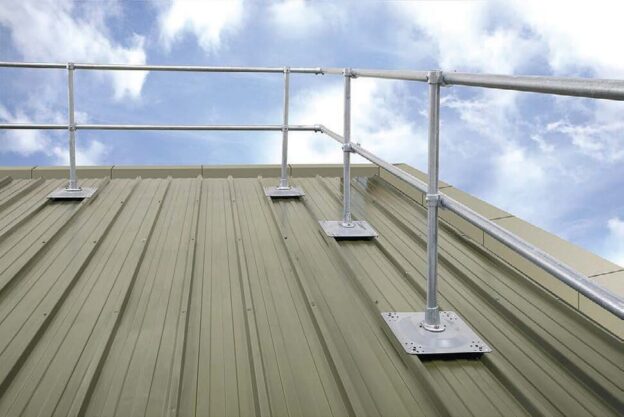Fall protection Guard rail systems are critical safety components, particularly in jobs that risk falling from heights. They act as a physical barrier between workers and potentially harmful edges, providing worker safety. In many businesses, building guardrails is a wise decision and a need to satisfy safety regulations. This blog will review the best methods for erecting guardrails to ensure optimal worker safety.
Further, guardrails are critical in preventing falls, which are one of the leading causes of workplace accidents, particularly in construction, manufacturing, and industrial environments. Falls may cause significant injuries and even fatalities. Thus, it is vital to establish suitable safety precautions. These systems are part of passive fall protection systems, meaning workers do not need to do anything to stay safe. The reason is that the existence of the guardrail automatically protects them.
Step-by-Step Guide to Install Guardrails
Guardrails must be installed according to certain requirements to provide the best possible protection. The following are the critical actions you should take:
1. Assess the Work Area
Before you begin building a Guard Rail System, you should properly inspect the work area. Look for any edges or platforms where workers may fall. These might include rooftops, elevated walkways, scaffolding, or mezzanines. Identifying these dangers will allow you to establish where guardrails are required. During this evaluation, it is also vital to consider the precise sort of work being performed since this might influence the design and location of the guardrails.
2. Select the Correct Type of Guardrail
Depending on your demands, you may pick from a variety of guardrails. A temporary guard rail system from US Fall Protection benefits short-term projects or regions where work is only sometimes completed. They may be placed and removed as required. On the other hand, permanent guardrails are a preferable choice for situations with a persistent risk of falling, such as balconies or high pathways. Both types of guardrails must exceed industry safety regulations and be composed of long-lasting materials that can survive harsh circumstances. Steel, aluminum, and even heavy-duty plastic are popular materials used in guardrails, each with varying levels of strength and longevity.
3: Ensure Proper Height and Strength
One of the most crucial components of building guardrails is ensuring they are at the proper height. According to safety recommendations, the top rail should be at least 42 inches tall, but verify your local safety laws for precise requirements. The guardrail must be sturdy enough to withstand pressure. For example, the top rail should sustain a force of at least 200 pounds without bending or giving way. This guarantees that the guardrail remains solid even when someone leans against it.
4. Install Toeboards for Extra Protection
Toeboards are an extra safety component that should be considered when erecting guardrails in certain scenarios. These little barriers run down the bottom of the railing to keep things from being kicked or knocked off the edge. Toeboards are vital in areas where tools, trash, or equipment may fall from heights, protecting both workers and those below.
5. Secure Guardrails to the Structure
A guard rail system is only as effective as the placement. It is critical to ensure that the guardrails are securely fastened to the structure where they are installed. This includes utilizing the appropriate fasteners, such as bolts or brackets, and ensuring that they are correctly secured. Guardrails that are loose or improperly fastened have the potential to fail, endangering workers. Depending on the surface on which you’re placing the guardrail, you may need to use different techniques to secure it. For example, guardrails erected on a flat roof may necessitate specific roof anchors. At the same time, those built on concrete or steel buildings may require bolts or welds to remain in place.
6: Regular Inspection and Maintenance
Once built, the guardrails must be examined on a regular basis to ensure their continued good condition. Weather conditions, wear and tear, and accidental damage can all cause the guardrails to deteriorate. Regular maintenance allows you to identify these concerns before they become severe problems. Check that the guardrails are still firmly connected, inspect for rust or corrosion, and repair any broken components.
7. Teach Workers about Guardrail Safety
Even though guardrails are part of Passive Fall Protection Systems and do not need workers to take action, it is still critical to instruct them on safety measures. They must understand how to utilize work areas properly, prevent overloading or placing too much weight on the guardrails, and report any damage symptoms. A well-informed workforce is safer, so ensure that safety training includes information on how guardrails protect workers.
Common Mistakes to Avoid While Installing Guardrails
While building guardrails may appear simple, certain typical flaws impair their efficiency. Here are some things you should avoid:
Incorrect Spacing: Check that the rails, posts, and toeboards are spaced appropriately. If the gaps are too big, the guardrail may need to provide more protection.
Weak Fastening: Always ensure the guard rail system is correctly secured to the structure. Weak or loosened fasteners might cause the guardrail to fail in an emergency.
Ignoring Local Safety Requirements: Always adhere to the safety requirements established by local authorities or OSHA. Failure to satisfy these requirements may result in fines and endanger workers.
Guardrails under Extreme Conditions
Guardrails may also require extra thought in severe weather conditions. Materials that can survive the elements should be used in places with severe rain, snow, or high winds. Guardrails should also be examined on a regular basis in such situations to verify they have not degraded due to exposure to moisture, cold, or heat. Further, the industry must comprehend how these environments might influence the integrity of the guardrails. Corrosion-resistant materials, such as stainless steel or specifically coated metals, are appropriate for regions subjected to moisture or chemicals.








